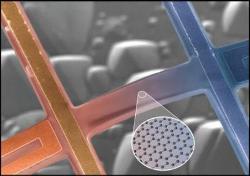Apr 11 2010
The single-atom thick material graphene maintains its high thermal conductivity when supported by a substrate, a critical step to advancing the material from a laboratory phenomenon to a useful component in a range of nano-electronic devices, researchers report in the April 9 issue of the journal Science.
 A one-atom thick sheet of graphene (highlighted in the circular window) on top of a silicon dioxide support proves to be an excellent thermal conductor, according to new research published in the journal Science.
A one-atom thick sheet of graphene (highlighted in the circular window) on top of a silicon dioxide support proves to be an excellent thermal conductor, according to new research published in the journal Science.
The team of engineers and theoretical physicists from the University of Texas at Austin, Boston College, and France's Commission for Atomic Energy report the super-thin sheet of carbon atoms - taken from the three-dimensional material graphite - can transfer heat more than twice as efficiently as copper thin films and more than 50 times better than thin films of silicon.
Since its discovery in 2004, graphene has been viewed as a promising new electronic material because it offers superior electron mobility, mechanical strength and thermal conductivity. These characteristics are crucial as electronic devices become smaller and smaller, presenting engineers with a fundamental problem of keeping the devices cool enough to operate efficiently.
The research advances the understanding of graphene as a promising candidate to draw heat away from "hot spots" that form in the tight knit spaces of devices built at the micro and nano scales. From a theoretical standpoint, the team also developed a new view of how heat flows in graphene.
When suspended, graphene has extremely high thermal conductivity of 3,000 to 5,000 watts per meter per Kelvin. But for practical applications, the chicken-wire like graphene lattice would be attached to a substrate. The team found supported graphene still has thermal conductivity as high as 600 watts per meter per Kelvin near room temperature. That far exceeds the thermal conductivities of copper, approximately 250 watts, and silicon, only 10 watts, thin films currently used in electronic devices.
The loss in heat transfer is the result of graphene's interaction with the substrate, which interferes with the vibrational waves of graphene atoms as they bump against the adjacent substrate, according to co-author David Broido, a Boston College Professor of Physics.
The conclusion was drawn with the help of earlier theoretical models about heat transfer within suspended graphene, Broido said. Working with former BC graduate student Lucas Lindsay, now an instructor at Christopher Newport University, and Natalio Mingo of France's Commission for Atomic Energy, Broido re-examined the theoretical model devised to explain the performance of suspended graphene.
"As theorists, we're much more detached from the device or the engineering side. We're more focused on the fundamentals that explain how energy flows through a sheet graphene. We took our existing model for suspended graphene and expanded the theoretical model to describe this interaction that takes place between graphene and the substrate and the influence on the movement of heat through the material and, ultimately, it's thermal conductivity."
In addition to its superior strength, electron mobility and thermal conductivity, graphene is compatible with thin film silicon transistor devices, a crucial characteristic if the material is to be used in low-cost, mass production. Graphene nano-electronic devices have the potential to consume less energy, run cooler and more reliably, and operate faster than the current generation of silicon and copper devices.